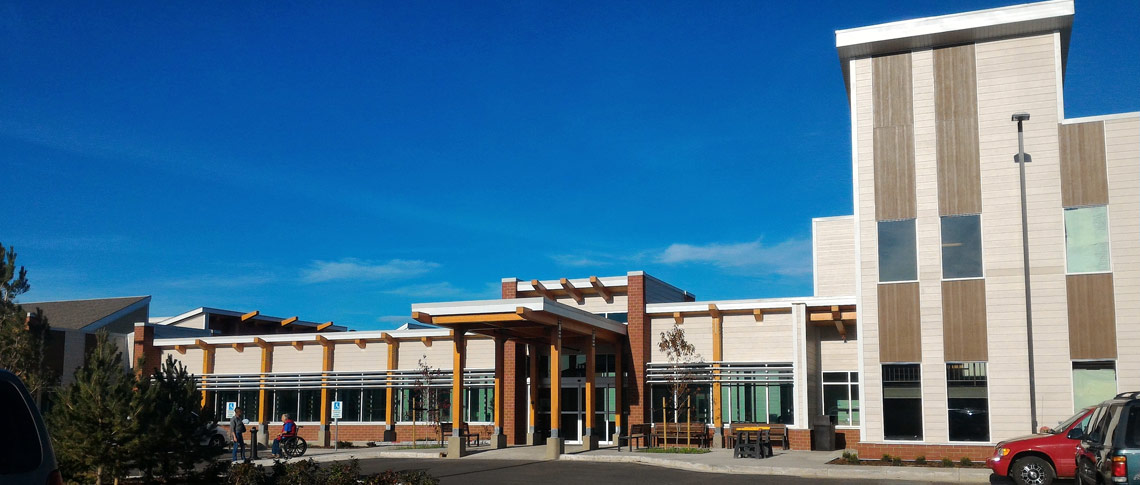
January 13, 2016

Meadow Ridge Seniors Village, above, an 84-bed supportive living facility in Medicine Hat, opened earlier this fall. Howard Osgood, inset, was one of the first new residents to move in. He says one of the best things about his new home is the food
Story by: Lisa Squires
Seniors might worry about the prospect of moving from their own homes into supportive living or long-term care, but planning ahead can make the transition easier, as the Osgood family recently learned.
When 90-year-old Howard Osgood was in hospital, it was clear to his sister Velma Pancoast, 88, and brother Kaye Osgood, 84, that Howard would not be able to return home after he was discharged. They knew, too, that Howard would need more support than the family could provide – so they set out to find their brother a new home.
Pancoast and Osgood toured a number of supportive living facilities in Medicine Hat under contract with Alberta Health Services (AHS). They finally settled on the new Meadow Ridge Seniors Village, an 84-bed supportive living facility that opened in the city earlier this fall.
And on Sept. 28, Howard moved in.
“Everything’s new in this place except the people,” jokes Howard, a Second World War veteran and former employee of the Canadian National Railway. “The food is great. Staff are really good. I really like it here. It’s a nice place.”
Estimates show that by 2031, more than 923,000 people in this province – one in five Albertans – will be over age 65, prompting many families to make some important decisions about next steps for their aging loved ones.
Dr. Cesar Rodriguez Velez, a geriatrician at Medicine Hat Regional Hospital, explains that as people age, their ability to perform everyday activities changes. People may need help with tasks like preparing meals, getting dressed, using the toilet, managing medications, or shopping and banking. So when a loved one begins struggling and requires regular help from family and/or home-care support, Rodriguez Velez says that’s a signal it’s time to get help or to start having conversations about moving.
Once someone is assessed at requiring a continuing-care level, families are provided with a list of facilities with AHS-funded beds that can provide this level of care in the community.
“I want seniors to be in control of their lives,” Rodruiguez Velez says. “The best way to do this is to plan early. Talk with Home Care, get assessed and go take a look at facilities available in your area. Things can progress while you wait for a place to become available. By the time the place is ready, you’ll be ready. There are great community resources available. Get help early, even if it means having Home Care come and help with the most basic things.”
Because the facility was so new, the Osgoods were able to move Howard in slowly over the course of a week. Family assisted with the move. Pancoast and Osgood took care of details including changing Howard’s address, utilities and arranging to have his medications sent to a new pharmacy. They also made arrangements with a local company to rent special equipment Howard would need, like an electronic bed similar to those in hospital, and a wheelchair.
“While Howard was in hospital, we stored his belongings, but you can only bring so much, so you have to decide what’s most important,” says Osgood. “You might not be able to fit a queen-size or double bed so you need to get a single.”
When deciding on the best option for your loved one, Colin Zieber, Executive Director, Seniors Health in the South Zone, says AHS can help. Assessments are conducted by a Home Care case manager using a common, internationally recognized assessment tool that identifies an individual’s needs. This information is then provided to an access centre for further evaluation, taking into account factors like the person’s care needs, where beds are available, urgency, and the ability to match individuals with their preferred facility.
“You want those assessing and placing people to have a community perspective, people who understand how individuals, with some effort and support, can remain independent in the community,” says Zieber. “In a supportive living environment, Home Care helps develop care plans and reassesses individuals. For example, if someone becomes confused, Home Care managers use their training and skills to determine if a physician needs to see the individual or whatever else might need to occur.”
The opening of Meadow Ridge meant a drop in the number of people waiting for placement. At press time for this issue, 35 people were waiting for placement at a supportive living facility in the Medicine Hat area – compared with weekly averages of up to 50 people, as experienced earlier this fall. Zieber says a recent announcement by Sarah Hoffman, Minister of Health to open a 100-bed long term care and dementia care facility in Medicine Hat in 2017 will provide additional options for area residents.
Residents in supportive living and long-term care pay an accommodation charge to cover the cost of rooms, meals, housekeeping and routine building maintenance. Alberta Health sets the maximum charge in designated supportive living and long-term care. In other types of supportive living settings, the charge is set by the operator.
Pancoast and her family say they appreciate the support they’ve received and are grateful Howard found a place to call home.
“It’s everything you could want for seniors,” says Pancoast.
For more information, contact your local Home Care office or call toll-free 1.866.388.6380. Or visit ahs.ca/cc/Page13154.aspx.